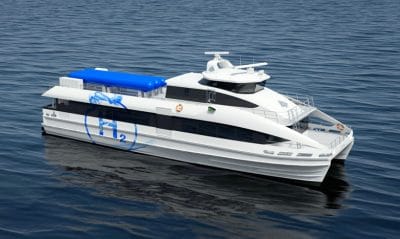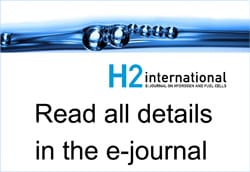One of the most important pillars of Norway’s economy, the maritime sector, is closely tied to the petroleum and natural gas industry. Using highly specialized ships and underwater equipment, offshore oil platforms are constructed, equipped and maintained as well as assembled and anchored to the seabed along the coast of Norway. The country has one of the largest merchant fleets in the world, and a large part of its public transport is done over water. Cars and passengers are ferried to neighboring countries, along the coast of Norway’s fjords or between its many islands. The default fuel, however, is still diesel, despite its effects on the climate and the environment.
…
A pioneer in hydrogen
The “hydrogen highway” that was imagined was reduced to a small handful of stations around the capital. The fuel cell vehicles were also missing from the actual picture, as they were everywhere else they were supposed to be found. In addition, leading Norwegian companies that were originally driving hydrogen forward gradually backed away from the technology with the unclear future. Two such companies, Statoil and Norsk Hydro, started the withdrawal after their merger in 2007. The final step was to hand the electrolyzer business over to Nel Hydrogen in 2011. Since then, Nel has become one of the most experienced companies in supplying hydrogen system components.
…
Today, Norway is one of the richest nations in electric means of transportation. No other country has more electric cars per capita. More than one out of every three newly registered vehicles have an electric motor. Since new electric car users are probably not looking for alternatives, the introduction of hydrogen and fuel cell technology in land transport at this time seems superfluous.
In 2015, however, after intensive lobbying from the Norwegian Hydrogen Forum and associated groups, the government put hydrogen implementation back into the white papers on energy supply. The issues arising from the changes in climate protection and renewable energy policy, that is, electricity surpluses and network bottlenecks, might be one reason why hydrogen use in Norway is back at the center of political discussion. Norwegian hydrogen and fuel cell companies are ready for it. In order not to miss any important developments, many in recent years have been heavily involved in the EU-funded projects set by the Fuel Cells and Hydrogen Joint Undertaking and in the activities of other international organizations.
A special kind of challenge
Unlike many other countries in Europe, Norway does not have to look hard for rich sources of renewable energy. The country has long relied on renewables and, today, generates nearly a hundred percent of its electricity from hydropower. It also produces a significant amount of surplus energy, about 10 terawatt-hours per year, which naturally varies depending on the day and season. Although the country in northern Europe considered grid connection and electricity exchange with its neighbors, that is, Sweden, Denmark, Finland and Russia, from the start, it is now increasingly testing the limits of the transmission network.
…
The large quantities of green hydrogen that could be produced in Norway by means of electrolysis have attracted many players in the energy business, since new opportunities to export it might open up. In addition, Norway’s maritime industry has realized that it could significantly reduce its emissions by fueling ships with hydrogen. For now, the fact is that the international shipping sector has agreed on liquid natural gas for maritime propulsion, since it is much more climate-friendly than diesel. However, hydrogen could be used to reduce emissions from ship fleets moving around the region or country all the way to zero. The focus here would be on car and passenger ferries, express ferries operating as water taxis and large excursion boats for giving tours.
…
An H2 high-speed passenger ferry
In 2015, the first purely battery electric ferry, B/F Ampere, went into use on the Sognefjord between Lavik and Ytre Oppedal. In 2016, Vision of the Fjords, a cruise ship that mainly used electricity for propulsion despite being a hybrid, was presented and sent on its path along the Naeroyfjord. It has become clear to the participants in the project that further solutions would need to be made before electric ships could cover longer distances or before more powerful vessels could run on electricity alone. For this purpose, the use of fuel cells as range extenders in battery electric ferries is now being investigated.
An initial prototype for a fuel cell high-speed passenger ferry was conceived. It is to be built in the coming years and go into operation in 2021. The ship will have a length of 30 meters, or 98 feet, and is designed for up to 100 passengers. A decisive factor for initiating this project was the great potential to reduce diesel fuel use and thus emissions.
…
In order to meet hydrogen demand for the new ferry, an electrolyzer and a new gas station at corresponding capacities will be built with the support of the local government in Floroe. It can also provide the current required for electrolyzer operation; of the nearly 16 terawatt-hours of electricity produced in the administrative district using water and wind power, there is today more than 8 terawatt-hours in surplus. Since construction of the whole infrastructure is not possible at the current pier for high-speed ferries, an entire facility is being built on an island opposite it. This island will be further expanded to accommodate the new system.
The large-scale project is being funded by the regional government and the participating municipalities. Coordinated by the local administration of Floroe, three companies from the region have joined forces to work on the project: Broedrene Aa, in Hyen, specializing in the manufacture of carbon fiber fast ferries; Mancraft, in Bergen, an expert in boat propulsion systems manufacture; and Skyssbat, the public transport company that will operate the ferry around Floroe starting in 2021.
…
Floroe is located in the county of Sogn og Fjordane, in the west of the country. Norway’s largest fjord, the Sognefjord, is also in this area. Fifty-five percent of public transport emissions in the county comes from ships. Fast ferries with a travel speed of up to 30 knots, which is approximately 56 kilometers or 35 miles per hour, are an important means of transportation in the region. They not only connect the archipelagos to the mainland; they can also be used to reach the cities and municipalities along the coast and the fjord much faster than with cars and intercity buses. Regarding the project, the regional government is concerned with not only the technical feasibility and working demonstrations, but also the value added to its economy and any new opportunities that could come from it.
Written by Alexandra Huss




























0 Comments